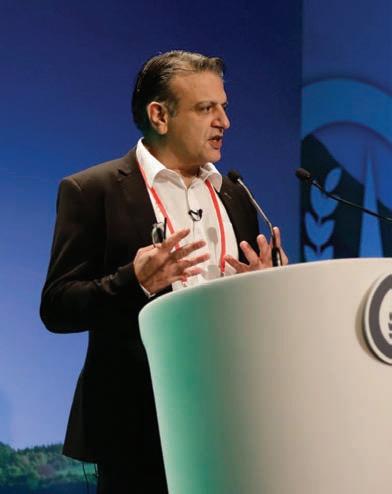
5 minute read
Health risks of low/no meat diets
Red meat rumpus rebuffed
Red meat and dairy are taking flak in health and environmental debates. But is it justified? Here Charles Abel reviews some key health issues, and over the page considers ways to better meet consumer demands
Advertisement
Prof Alice Stanton of Ireland’s Royal College of Surgeons and Devenish Nutrition
HAVE YOUR SAY Share your views on the role of meat/dairy/veggie in the health/ environment/ climate change debate. Email: editor@ thefarmers club.com CONTRARY to the findings of last year’s EATLancet investigation into sustainable human diets both red meat and dairy products have a vital role to play. Attention instead needs to turn to balancing the nutrient density of foods with the environmental impact taken to produce them.

So says Alice Stanton, Professor of Cardiovascular Pharmacology at the Royal College of Surgeons in Ireland and also Director of Human Health at Devenish Nutrition.
EAT-Lancet suggested diets needed to shift from the UK Government’s Eatwell guide, which recommends a diet of one-third plant-based (fruit and veg), one-third cereals and one-third animal-sourced (meat, dairy etc) to twice as much fruit, veg, legumes and nuts and half the amount of animal sourced, with a 90% reduction in red meat consumption.

The logic was that animal-sourced foods were causing damage to the planet. Eating more plantbased foods was necessary to save the planet. The public went a step further and assumed animal-sourced foods damaged human health too.
Health impacts of diet
In Lancet’s April 2019 issue Chris Murray, one of the EAT-study authors, reported that nutritional factors were really important, with 15 key factors more important than smoking or disease when assessing human health impacts, measured in DALYs (see panel). That has big implications for human misery, health care costs and death.
Of the 15 top factors a diet low in grains scored highly, as did a salty diet, and diets deficient in vegetables, fruits, nuts, seeds and omega 3 fatty acids. Significantly, diets with
too much red meat came well down the list, accounting for just 0.5% of DALYs.
In studies where red meat caused higher DALYs high consumption was considered to be more than a portion a day. By contrast 2-5 portions a week appeared to reduce DALYs. Moderate red meat consumption appeared to be protective.
Red meat is rich in amino acids and micronutrients such as iron, selenium and zinc, with iron deficiency already responsible for considerable disease burden, especially fatigue and impaired childhood development, with childhood stunting and impaired brain development impacting academic learning and career development.
Globally low meat consumption is associated with Africa and Asia, where childhood stunting exceeds 30%. Although other factors may be at play a Harvard study of school-children fed extra vegetable stew, meat or milk at school showed those receiving extra meat improved academic results by 20%.
The EAT-Lancet diet recommends a halving of dairy intake. But researchers are already clear that dairy reduces DALYs, Prof Stanton noted. The PURE study in the Lancet showed more than two dairy servings a day cut major cardio-vascular disease and mortality by 25% compared with a diet of less than half a serving. “So what happens if we reduce to a maximum of one portion?” Significantly, the data was strongest for whole-fat dairy, and least for low-fat.
Nutrient density key
The prospect of doubling fruit and veg intake, from five to ten portions a day, seems unrealistic, given that most people currently fail to manage five-a-day. “My thoughts are that we need to balance and optimise human nutrient intake, while reducing carbon footprint.” That means looking at nutrient density per unit of greenhouse gas emission.
Significantly, wholefoods delivered far more nutrient per unit of emissions than processed foods. Furthermore, ultra-processed foods were likely to cause obesity, due to additives included, whereas wholefoods typically brought weight loss.
Furthermore, veggie burgers, while nutrient dense, were high in salt and additives, to increase consumption, making them a poor health option.
Currently, an unprocessed wholefood diet could cost £150/week, compared with £100 for ultra-processed foods. That sent the wrong signals. Taxes and subsidies could help shift perceptions. A 30% healthy foods subsidy has been calculated to be capable of cutting cardiovascular disease by 30%, DALYs by 8.4 million and save £billions in healthcare costs.
Breeding for more nutrient dense foods could help, especially when it comes to omega-3 fatty acids. Important for brain development, international guidelines suggest 250mg/day consumption. Less than a fifth of the world achieves that, with the UK scoring poorly. A halving of omega-3 content in farmed salmon over the past 10 years could be partly to blame, as omega-3 rich wild fish by-product in feedstuffs has tumbled.
Reversing that is important. Algal production could help, but is costly. Camelina oilseeds genetically engineered for high omega-3 are another alternative.
Trials by nutrition firm Devenish have shown that high omega-3 feed for chickens raises omega-3 levels in meat and eggs, raising levels in humans eating them, potentially reducing the risk of heart attack, stroke, dementia and depression.
Food labelling has a role to play too. Shifting from purely sign-posting negative aspects of foods, to including beneficial aspects too, could help tremendously, she suggested. Improving convenience would be important too.

Switching to lab-grown meat alternatives might be seen as an option, but would still require potentially unsustainable nutrient and energy inputs. “And there’s the cultural element too – do we really want to eat the equivalent of dog food,” Prof Stanton concluded.
MORE INFO Paper as given at Oxford Farming Conference 2020: www.ofc.org.uk/ conference/2020/ papers See also: www.gov.uk/ government/ publications/theeatwell-guide www.us.devenish nutrition.com/ products-services/ poultry/c/specialityproducts1/ omegapro
EAT-Lancet Report
The EAT-Lancet report reviewed what constitutes a healthy diet from a sustainable food system, and actions to support and speed up food system transformation. The EAT-Lancet Commission on Food, Planet, Health brought together 37 world-leading scientists to answer the question: Can we feed a future population of 10 billion people a healthy diet within planetary boundaries? The answer was YES, with the caveat that it would be impossible without transforming eating habits, improving food production and reducing food waste. www.eatforum.org/eat-lancet-commission
DALYs
Disability-Adjusted Life Years for a disease or health condition are calculated as the sum of the Years of Life Lost due to premature mortality, plus Years Lost due to Disability, for people living with the health condition or its consequences. www.who.int/healthinfo/global_burden_disease/metrics_daly/en










